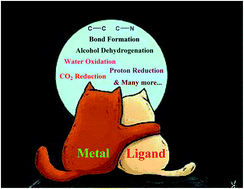Metal–ligand cooperative approaches in homogeneous catalysis using transition metal complex catalysts of redox noninnocent ligands†
Abstract
Catalysis offers a straightforward route to prepare various value-added molecules starting from readily available raw materials. The catalytic reactions mostly involve multi-electron transformations. Hence, compared to the inexpensive and readily available 3d-metals, the 4d and 5d-transition metals get an extra advantage for performing multi-electron catalytic reactions as the heavier transition metals prefer two-electron redox events. However, for sustainable development, these expensive and scarce heavy metal-based catalysts need to be replaced by inexpensive, environmentally benign, and economically affordable 3d-metal catalysts. In this regard, a metal–ligand cooperative approach involving transition metal complexes of redox noninnocent ligands offers an attractive alternative. The synergistic participation of redox-active ligands during electron transfer events allows multi-electron transformations using 3d-metal catalysts and allows interesting chemical transformations using 4d and 5d-metals as well. Herein we summarize an up-to-date literature report on the metal–ligand cooperative approaches using transition metal complexes of redox noninnocent ligands as catalysts for a few selected types of catalytic reactions.

- This article is part of the themed collection: Catalysis & biocatalysis in OBC


 Please wait while we load your content...
Please wait while we load your content...